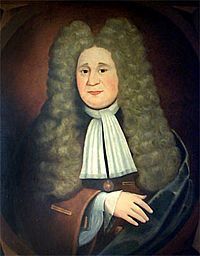John Coode (Governor of Maryland) facts for kids
Quick facts for kids
John Coode
|
|
|---|---|
| 1st Leader of the Protestant Associators of Maryland | |
| In office 1689–1690 |
|
| Preceded by | William Joseph (Proprietary Governors) |
| Succeeded by | Nehemiah Blakiston |
| Personal details | |
| Born | c. 1648 Penryn, Cornwall, Kingdom of England |
| Died | February or March 1709 |
| Profession | Colonial governor |
John Coode (born around 1648 in Cornwall and died in early 1709) is famous for leading a rebellion. This uprising overthrew the colonial government of Maryland in 1689. Coode was involved in four different rebellions. He also briefly served as Maryland's governor from 1689 to 1691. During this time, he was known as the 1st Leader of the Protestant Associators.
Contents
Early Life and Move to Maryland
John Coode was born in Penryn, Cornwall, Kingdom of England, around 1648. He came from a wealthy family in Cornwall. When he was 16, Coode attended Oxford University.
In 1668, Coode became an Anglican priest. However, he soon decided to leave his role as a minister. He did this to marry Susannah Slye. Susannah's father, Thomas Gerrard, was an important person in the colony. He also had disagreements with the ruling Calvert family. This connection helped shape Coode's growing dislike for the Maryland government.
Becoming Involved in Colonial Affairs
After marrying Susannah, Coode started to get involved in the colony's activities. Over the next few years, he gained several important positions. He was made a captain in the militia, which was like a local army. He also became a justice in Saint Mary's County. Later, he was elected to the Maryland Assembly, which was the colony's law-making body.
In 1681, Coode took part in a rebellion against the government. We don't know exactly what he did in this plot. But after it failed, he was arrested. Another former Maryland governor, Josias Fendall, was also arrested. Coode was later released on bail. However, he lost his official positions. The Calverts, who ruled Maryland, saw him as someone who opposed them.
The Protestant Revolution of 1689
In 1689, John Coode planned another rebellion. More and more Protestants were moving to Maryland. They were unhappy that most government jobs were held by Catholics or friends of the Calvert family. Many Protestants were also upset because Maryland's government had not yet recognized the new Protestant rulers of England. These were King William III and Queen Mary II. They had taken power from the Catholic King James II in England's Glorious Revolution of 1688.
Leading the Uprising
In April 1689, John Coode helped lead a group called "An association in arms." Their goal was to defend the Protestant religion. They also wanted to support King William and Queen Mary's right to rule Maryland. Coode gathered an army against Maryland's Catholic leaders. He also spread a rumor that Catholics had invited Native American tribes to attack Protestants.
Coode's army had about 700 men. They attacked the state house, which was the center of the government. It also held the colony's important records. His army then marched into Saint Mary's City. They forced the council to give up power. They defeated the government's army, which was led by Colonel Henry Darnall. Darnall later wrote that they surrendered to prevent bloodshed.
After the Victory
Coode and his group, who were mostly Puritans, now controlled the colony. They set up a new government. This new government made both Catholicism and Anglicanism illegal. Darnall lost all his official positions.
On August 1, 1689, Coode took charge of the government. He was called 'Commander-in-Chief'. He stayed in power until a new royal governor, Nehemiah Blakiston, was appointed on July 27, 1691. For a while, Coode was part of the new government. But he became unhappy again. He would later take part in two more uprisings against the colonial leaders.
In 1699, Coode faced accusations of speaking against the Christian faith. He was found guilty by a jury. However, the governor at the time, Nathanial Blakiston, pardoned him. This was done out of respect for Coode's past service in the 1689 rebellion.
Coode remained popular with the people of Maryland. They tried to elect him to the Assembly. But the council used the fact that he had once been a priest to keep him out of government. He spent the rest of his life away from the colony's politics. He died in February or March 1709.


